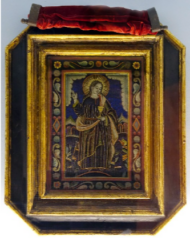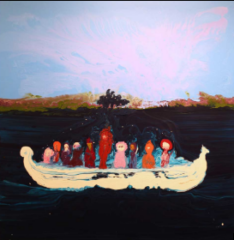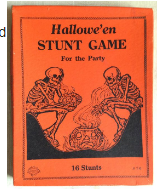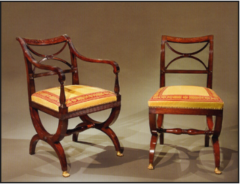The corners of the tapestry tell Marc Chagall’s story of faith. In the lower right is a person reading from the scripture. In the lower left is a rabbi doing the same. In the upper-left corner is a depiction of the crucifixion of Jesus. This configuration of Christ represents, for Chagall, the suffering of all mankind. In the upper-right corner is a depiction of the city of Jerusalem. Chagall felt that many people who experience a functional loss of ability rely on their faith to carry them through, and Jerusalem is the focal point of some faiths. Between the two upper corners is the angel Gabriel, coming to bring good news to Job. Below Gabriel is a goat. In the upper-left corner, Chagall created a gathering of people forming the shape of an evergreen tree. In this grouping, one can see, either in a real or illusional sense, various objects used by people with physical impairment, such as a wheelchair, canes, various braces (orthoses) and artificial limbs (prostheses). The work is immense at 13′ H x 1.5′ W and was designed to hang vertically.
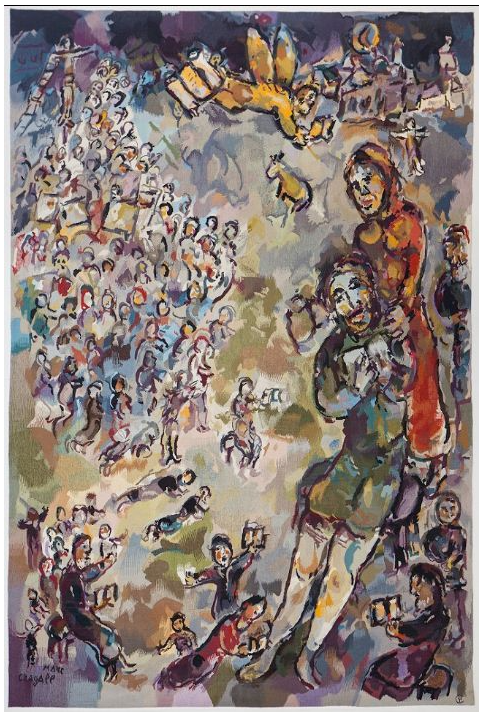
In 2022, Shirley Ryan AbilityLab – formerly the Rehabilitation Institute of Chicago (RIC) – contacted Veritas to appraise the Marc Chagall tapestry, Job, which has hung in the lobby of its two successive rehabilitation hospitals for nearly four decades. This work was Chagall’s last commissioned work, and Veritas was honored to assist the renowned hospital. In researching the tapestry, we became immersed in the rich and uplifting history of this masterpiece.
Established in 1953, Shirley Ryan AbilityLab is the global leader in physical medicine and rehabilitation for adults and children with the most severe, complex conditions – from traumatic brain and spinal cord injury to stroke, amputation, and cancer-related impairment. In March 2017, the organization built a new hospital and rebranded as Shirly Ryan AbilityLab. The new facility became the first-ever “transitional” research hospital in which clinicians, scientists, innovators, and technologists work together in the same space, surrounding patients, discovering new approaches, and applying (or “translating”) research in real-time.
So how did a tapestry by Mac Chagall end up in a renowned rehabilitation hospital in Chicago?
Chagall’s artistic work was not new to the Windy City – Chicago already boasted Chagall’s mosaic, The Four Seasons (1974), in Chase Tower Plaza, as well as his stained-glass America Windows (1977) at the Art Institute of Chicago. Tapestries were also not new to Chagall. Hos group of three tapestries hung in the state reception hall of the Israel Parliament, the Knesset (Entrance to Jerusalem also called Return to Zion, The Exodus, The vision of Isaiah, 1969).
In 1963, Chagall and his wife, Valentina (“Vava”), were in the States and Vava visited RIC. She had been invited to a meeting with the then-RIC medical director, Henry Betts, MD, and Vivian Jacobson, who had worked with Chagall in his early years and had served as president of The American Friends of Chagall’s Biblical Message Museum.
Dr. Betts discussed the motivating value of art in a place of healing, and how it inspires those who have great physical and emotional challenges to overcome. An idea was born to commission the tapestry, with Vivian Jacobson and the committee she established, Friends of the Chagall Tapestry, raising funds to support the effort.
Dr. Betts told Chagall that his works, above all other artists, share the same aura of hope that is offered to RIC’s patients. He wrote, “We try to demonstrate through our work, belief in the basic worth of human beings and to help our patients abstract from themselves whatever is the best in them, building on that, and then moving on to successes they may never have dreamed of before. Hope and faith are the issues – they are our main ‘product’ even beyond the medicine and technical skills. It is a hope that people, even in circumstances such as this, can find their way in the world.”
After reading the letter, Chagall asked Dr. Betts for a biblical passage to support the project, which the doctor found in Job 14:7: “For there is hope of a tree / if it be cut down, that it will sprout again / And that the tender branch thereof will not cease.” Thus it was that Chagall named this piece Job.
The tapestry resulting from this complex chain of events was Chagall’s last-commissioned work. It is, perhaps, the only work ever done by a great artist with a “therapeutic” goal in mind. he did it solely for those who have lost some ability, saturating the tapestry with the special blue, that, for Chagall, symbolized the continual hope of renewal. In keeping with the message of Job, it shows the community of mankind giving to each other.
On accepting this special commission, Chagall said, “Now, I am a doctor.”
Veritas believes that art is the highest form of hope – it inspires, soothes, accompanies and challenges. Shirley Ryan AbilityLab shares this truth and believes that “The Soul Moves First” – that the art of healing begins in the spirit – with the desire to get better, get started, push harder, hope, and dream. This rehabilitation hospital is indeed about the art of ability.
Shirley Ryan AbilityLab is a 501 (c)(3) nonprofit organization. For more information, go to www.sralab.org.
Veritas Fine Art Appraisals & Consuling, LLC
312.252.9772
inquiries@veritasartappraisals.com

